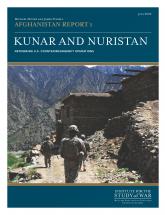 |
 |
Kunar and Nuristan: Rethinking U.S. Counterinsurgency Operations

Key Findings and Policy Recommendations
- Although counterinsurgency doctrine was successfully implemented in urban Iraq, it has proved more difficult to apply in the sparsely-populated mountains of Kunar and Nuristan.
- U.S. forces are disproportionately committed to defending marginally significant areas in these remote provinces.
- U.S missions in eastern Afghanistan, specifically places like the Korengal and Pech River Valley, must be re-examined and forces must be re-deployed to areas where they will have greater effect.
- The Korengal Valley in Kunar province is the deadliest place in Afghanistan. The population is historically hostile to any outside influence, including any Afghans from outside the valley.
- The Korengalis have successfully fought off every attempt to subdue their valley, including the Soviets in the 80s, the Taliban rule in the 90s, and currently, the U.S. military.
- The presence of U.S. forces in the Korengal generates violence and undermines U.S. efforts to bring stability and security.
- The current U.S. force disposition in the inhospitable valleys, like the Korengal, relies too heavily on isolated outposts that require massive amounts of artillery and airpower to defend
- U.S. forces are not denying the enemy the high ground, allowing insurgents to attack and terrorize the population.
- Artillery and airpower are counterproductive in dealing with the insurgency in this part of the country because their use alienates the very population the U.S. is trying to secure.
- Committing additional forces in order to hold this remote terrain would be tactically and operationally imprudent. The resistance in this area is confined to locals in the valley. It does not accelerate the insurgency beyond the valley.
- Counterinsurgency in Afghanistan requires less interdiction on the borders and greater security in the population centers. Resources must flow to areas that are strategic priorities in order to allow force densities high enough to practice counterinsurgency effectively.
- Rather than maintaining positions in the Korengal and many of the small, ineffective posts that dot the Pech river valley, U.S. forces should conduct active patrols in the populated areas of the lower Kunar River Valley.
- U.S. forces must protect the specific populations that oppose the enemy and support the government, rather than fighting populations that historically resist the government. U.S. forces in Kunar should concentrate efforts in places like Mara Wara, Sarkani and Khas Konar Districts where the population actually desires U.S. support and presence, unlike the Korengalis.
- Counterinsurgency requires short-term economic support, as well as a dense and mobile force presence. U.S. forces must pair long-term development projects, such as building roads, with short-term, immediate humanitarian assistance and quick-impact projects.